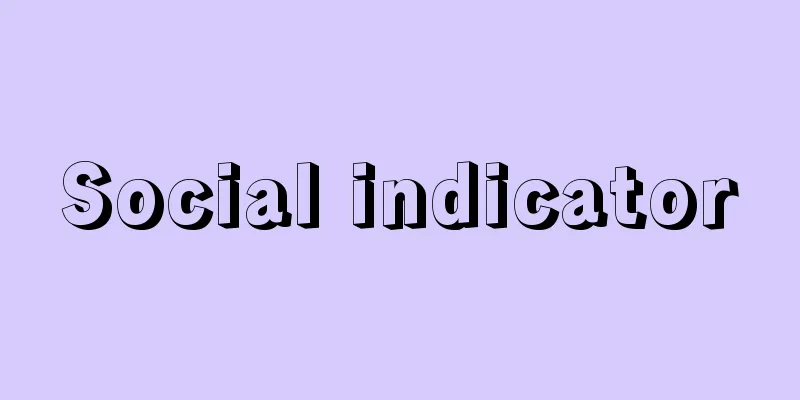Social indicator

|
Generally speaking, a social indicator is some kind of scaled indicator used to describe the state of a social system from an evaluative point of view. However, it was in the 1960s and 1970s that the so-called social indicators were actively discussed, and the idea of social indicators emerged as a way to measure the "level of welfare achievement" of national society, which could not be evaluated by the traditional "GNP principle." From an academic perspective, it was a problem of state evaluation and fluctuation measurement techniques in a macro social system model, but due to the above-mentioned circumstances, it was closely related to the political demand for the "scientificization of public policy." The usual approach in social indicator theory has been to limit the achievement of various requirements for a social system to practical concerns, to select a few areas as representing the overall "achievement of goals" of national society, and to introduce individual indicators for those. Representative items include health (including medical care, health services, nutrition, etc.), education, labor, leisure, employment, income, consumption, housing, the environment, safety (including public order, justice, crime, etc.), transportation, communications, social security, and family life. However, a major problem is how to "integrate" the individual indicators for these items to convert them into an overall indicator, and at the same time, the apparent size of the indicator can have a completely different meaning depending on what is chosen as the "standard of evaluation." More fundamentally, the quantification of such social indicators (1) indicates an objective and rational (and therefore operational and clear) level of the social state, or a subjective level such as "desirability" or "satisfaction," and (2) how to deal with issues in areas where quantification is difficult or nearly impossible. Therefore, the idea behind social indicators is, on the one hand, the agreement that "social good" (social welfare) can be determined relatively, and, on the other hand, "operationalism" that says it can be measured by some quantitative method. This is the theory of social indicators, which specifically attempts to link the minimum level of satisfaction of certain life functions (social capital, social security, social insurance) to policy proposals as a "civil minimum," or to envision a "life system" that expands the theory of functional requirements of the social system and to use the idea of "life quality" to make the fulfillment of requirements more concrete. In practice, administrative bodies (such as local governments) often comprehensively grasp the living standards and life satisfaction of residents and citizens, and use this information to improve administrative services. [Shuichiro Nakano] "Social Indicators" edited by R. A. Baur, translated by Seisuke Komatsuzaki (1976, Sanno University Press) " ▽ "Theory of Welfare and Social Planning" by Takashi Mieno (1984, Hakuto Shobo)" ▽ "Economic Growth, Development and Welfare - Regarding the Standard of Living of the Nation" by A. K. Dasgupta, translated by Kenzo Mizukami and Yoshimasa Hasegawa (1995, Bunka Shobo Hakubunsha)" [References] | | | | |Source: Shogakukan Encyclopedia Nipponica About Encyclopedia Nipponica Information | Legend |
|
きわめて一般的にいえば、社会指標とは、社会システム(社会体系)の状態を評価的な視点から記述する際に用いられるなんらかの尺度化されたインジケーターのことである。しかし、いわゆる社会指標がかまびすしく論じられたのは1960年代から70年代にかけてであり、それも従来の「GNP主義」では評定不可能な国民社会の「福祉達成水準」を測るべきものとして、社会指標という考え方が登場したのである。それは、学問的な関心としては、マクロ社会システム・モデルにおける状態評価や変動測定の技術の問題であったが、前記のような事情のため、「公共政策の科学化」を目ざす政治的要請と密接に関係していた。 社会システムの諸要件達成を実践的な関心にあわせて限定し、国民社会の全体的な「目標達成」を表すものとして若干の領域を取り上げ、それらに対して個別的な指標を導入するというのが、これまでの社会指標論の常套(じょうとう)手段であった。このような代表的項目としては、健康(医療、保健サービス、栄養などを含む)、教育、労働、余暇、雇用、所得、消費、住居、環境、安全(公共の秩序、正義、犯罪などを含む)、交通、通信、社会保障、家庭生活などがあげられている。しかし、こうした項目に対する個別指標をどのような形で「総合化」して全体的指標に変換するかが大きな問題であり、同時に「評価の基準」を何に求めるかによって指標の見かけ上の大きさの意味がまったく異なるということもある。より基本的には、このような社会指標という数量化が、(1)社会状態の客観的・合理的(したがって操作的・明晰(めいせき)的)な水準を示すのか、あるいは「望ましさ」とか「満足度」とかいう主観的な水準を示すのか、(2)数量化が困難かあるいは不可能に近い領域の問題はこれをどのように取り扱うか、というような問題も残る。 したがって、社会指標を基礎づけている考え方は、一方では「社会の善」(社会福祉)を相対的に確定しうるという合意であり、他方ではそれがなんらかの数量的方法によって測定可能であるとする「操作主義」である。一定の生活機能(社会資本、社会保障、社会保険)の最低限度の充足水準を「シビル・ミニマム」として政策提言に結び付けてゆく方法、あるいは社会体系の機能要件論を拡大した「生活システム」を構想し、要件充足をより具体化した「ライフ・クオリティ」の考え方などが具体的に試みられている社会指標論である。実践例としては、おもに行政主体(地方自治体など)が、住民・市民の生活水準や生活満足度などを包括的に把握して、行政サービス改善のための情報として利用することが多い。 [中野秀一郎] 『R・A・バウア編著、小松崎清介訳『社会指標』(1976・産業能率大学出版部)』▽『三重野卓著『福祉と社会計画の理論』(1984・白桃書房)』▽『A・K・ダスグプタ著、水上健造・長谷川義正訳『経済成長・発展・厚生――国民生活の水準をめぐって』(1995・文化書房博文社)』 [参照項目] | | | | |出典 小学館 日本大百科全書(ニッポニカ)日本大百科全書(ニッポニカ)について 情報 | 凡例 |
Recommend
Heitland, WE (English spelling)
...They are broadly divided into internal causes ...
Echinoderm - Echinoderm
A group of animals that make up a phylum, the hig...
Geometric Tolerance - Geometric Tolerance
...Such shape and position accuracy indicates the...
Neap tide - Koshio
During a first or last quarter, the directions of ...
tension test
…In response to the demands of the times, the num...
Collection of Tosa Province Kanji - Tosa no Kuni tokanshu
This is a chronological collection of medieval doc...
"Old man education" - Oyajikyoiku
…You can open the can and eat it as a salad or fr...
Leptothrix
…They oxidize iron in the water and accumulate la...
Gonçalves, Nuno
Portuguese painter of the 15th century. He was act...
Opening Statement - Botoku
In a criminal case, after the opening procedure i...
Castelnuovo (English spelling) Guido Castelnuovo
1865‐1952 Italian mathematician. He graduated from...
Least squares method
A method for minimizing the sum of squares. The s...
New Usuyuki Monogatari - Shin Usuyuki Monogatari
Joruri Gidayubushi. Historical piece. Three acts....
Dermatocarpon myogiense (English spelling)
… [Hiroyuki Kashiwatani]. … *Some of the terminol...
Goose (gan) - gan (English spelling) goose
A general term for large birds belonging to the f...









